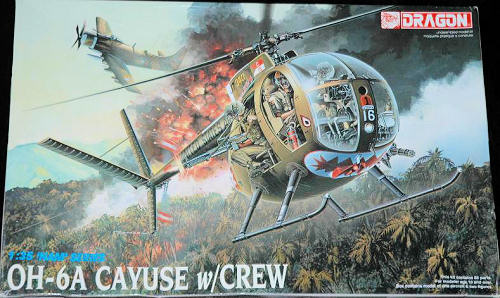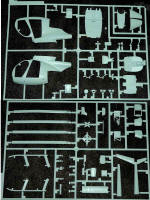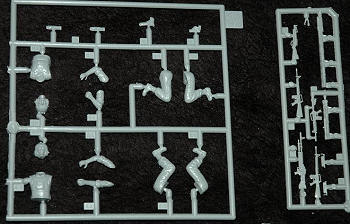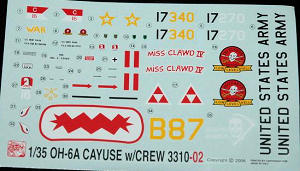
Dragon
| KIT #: | 3310 |
| PRICE: | NZ $42.50 |
| DECALS: | Two options |
| REVIEWER: | Zac Yates |
| NOTES: | Currently Out of Production |

| HISTORY |
Along with the
Production OH-6As entered
service in 1966, soon after entering the battlezones of
Large numbers of OH-6As still
fly in the
| THE KIT |
 This
is the first DML kit I’ve ever owned, so this will be a new experience for me. I
have, however, been a fan of the Hughes 369 since I was a very young child, so
I’ve built practically every other kit of the type on the market!
This
is the first DML kit I’ve ever owned, so this will be a new experience for me. I
have, however, been a fan of the Hughes 369 since I was a very young child, so
I’ve built practically every other kit of the type on the market!
Opening the box you find four
sprues of standard grey styrene, and one of clear, with a total parts count in
the instructions of 85. Everything looks to be very nicely moulded with very
little flash, although there are a large number of ejector pin towers to be
separated from many parts. Panel lines are a mix of engraved lines, and
prominent raised rivets. I don’t believe this would be scale, so the more
experienced among you may wish to “accurize” if possible.
The engine covers are moulded
separate to the main fuselage “egg”, which is odd as nothing is given in the way
of engine detail for this area. The instructions do say to cement them closed,
but one wonders why this was done. No doors are provided for the cabin, meaning
unless you scratchbuild a set, your finished build will have air conditioning
for the crew. I think this is how they would’ve flown in the humid skies of
Interior detail is very nice,
with a full set of controls provided and even – a first for me – a fire
extinguisher! The instrument panel has a very nice raised moulding, but no
detail is provided at all for the faces. No moulded detail, no decals, nothing.
The rotor head and mast detail is fair (some may want to improve on it) but,
from memory, better than the
One of the features which makes
the Loach so distinctive is its V-shaped tail, which on many kits is moulded as
separate, fiddly components. With this kit, however, the vertical components are
moulded with a tailboom half, with only the angled stabiliser and its boom to
affix. This looks to be quite easy due to the tab provided.
A nice touch is the inclusion of
two seated figures, representing the pilot and his gunner/observer. These are
superbly moulded, complete with separate holstered pistols and sheathed knives.
To go with them is a selection of  side of
the cabin. This is provided in the kit, as a faired weapon. Many operated
without the streamlined fairing, but for this you’ll have to scratchbuild or
hunt from another source.
side of
the cabin. This is provided in the kit, as a faired weapon. Many operated
without the streamlined fairing, but for this you’ll have to scratchbuild or
hunt from another source.
The decals are, yet again, very
nice and with minimal carrier film. Two individual aircraft are catered for:
17270 of E Troop, 1/9 Cav, 1st
Cavalry Division, based at Lai Khe in 1970, and 17340 of C Troop, 16th
| CONCLUSIONS |
To me this looks to be a fantastic kit, with loads of diorama potential and what seems to be fairly speedy assembly. Eduard make a photoetch set for this kit (in case you want to go all out), but even out of the box DML have provided enough for a great finished model. And, even at such a large scale, the completed aircraft is still less than two feet long, so won’t place a strain on display space.
I plan to get started on mine as soon as possible.
February 2009
If you would like your product reviewed fairly and quickly, please contact me or see other details in the Note to Contributors.